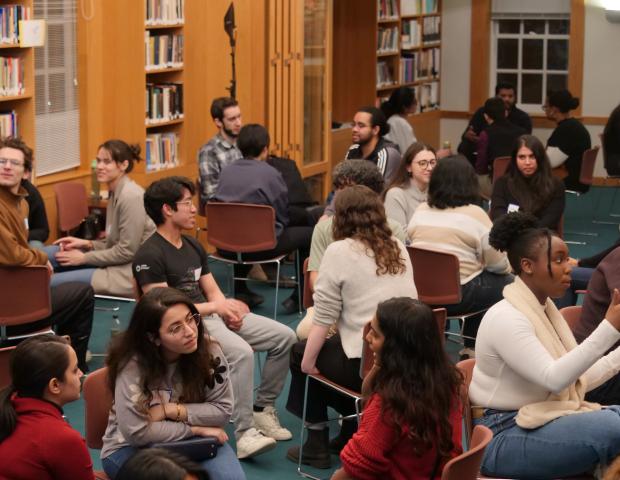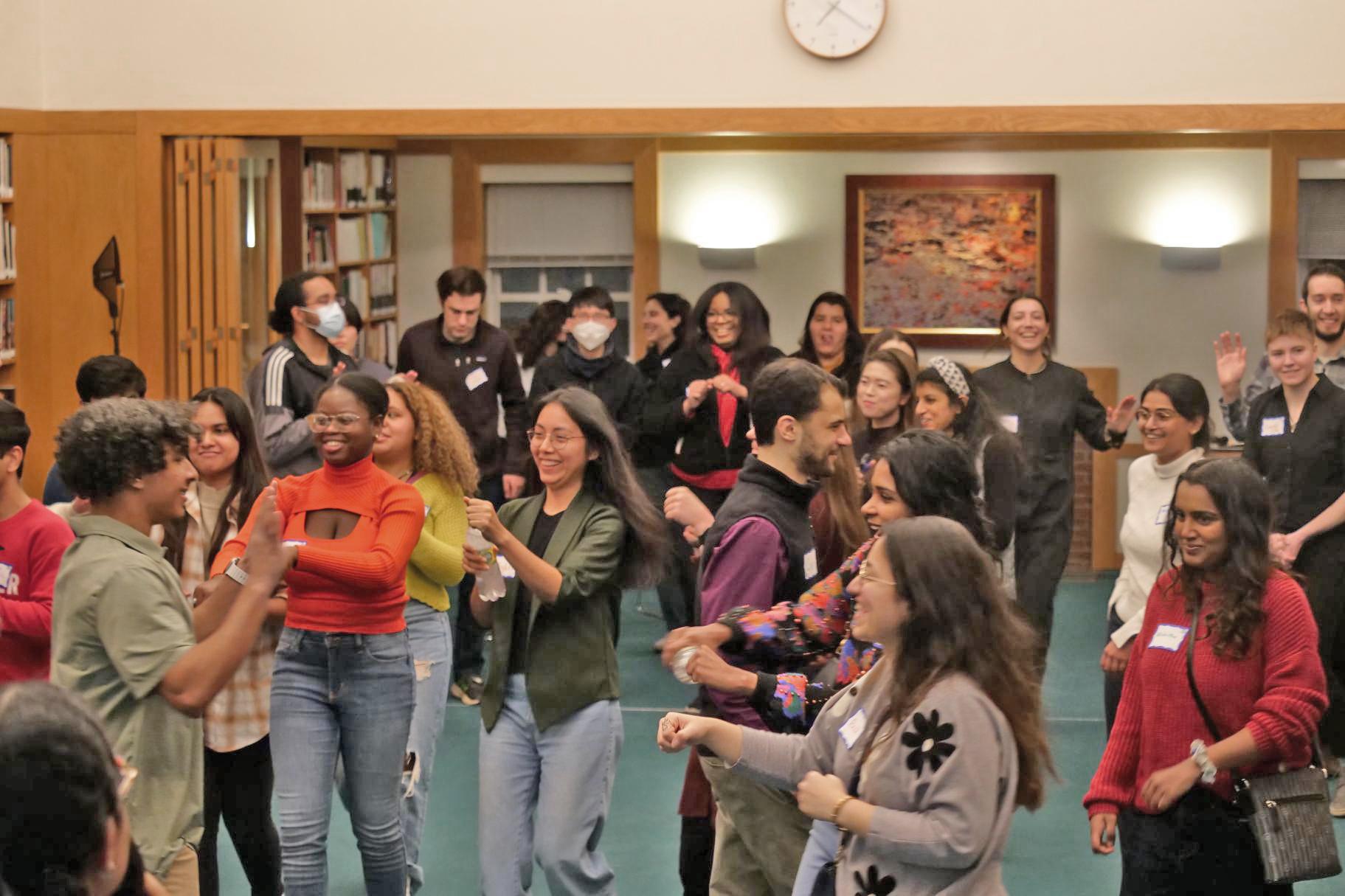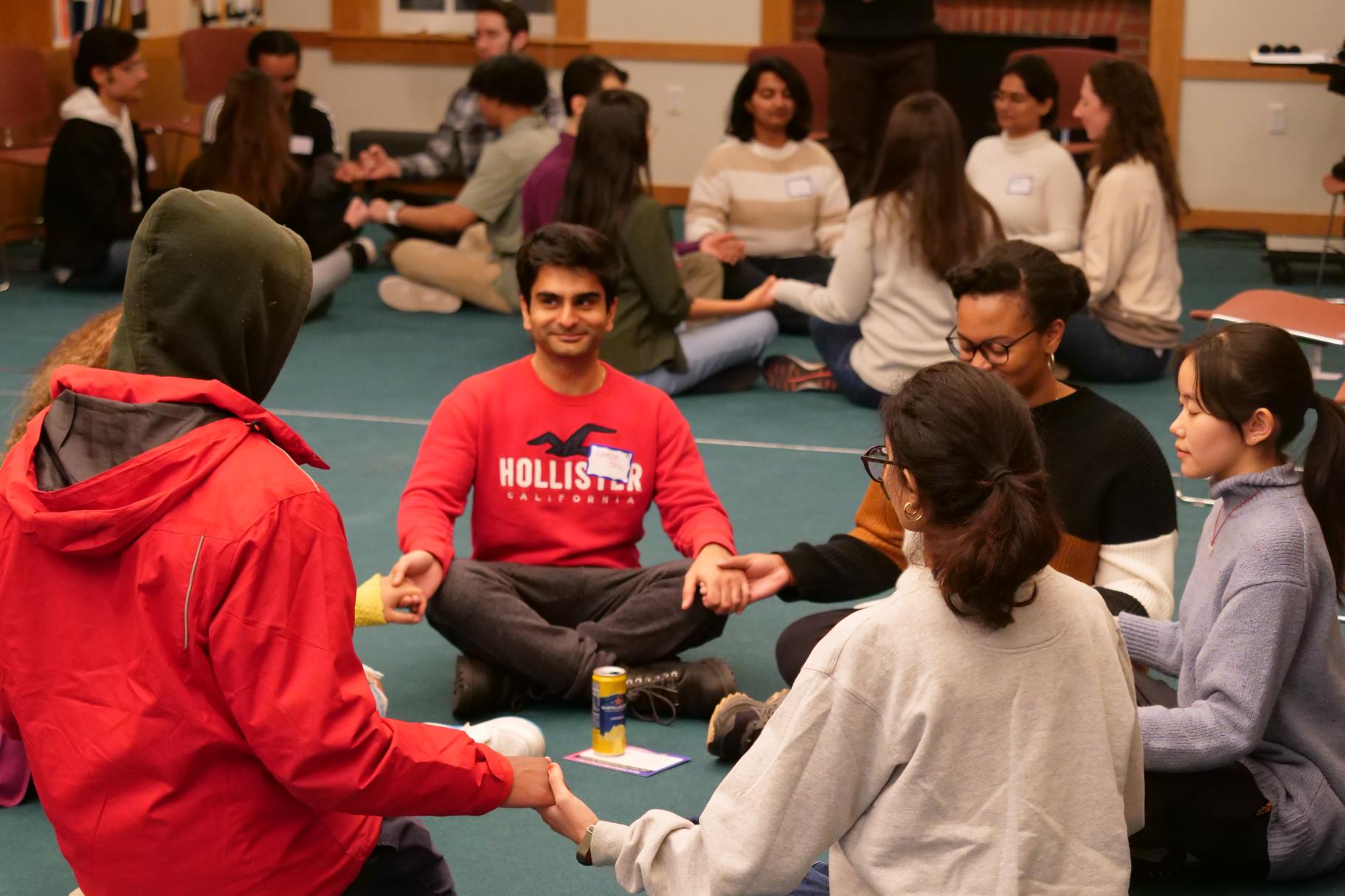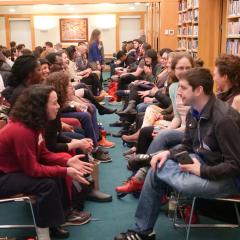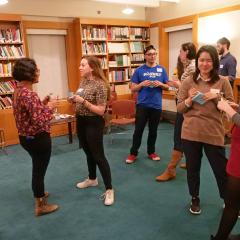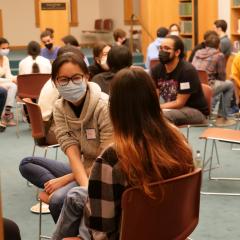Dialogue Nights #29: Responding to Stress in Stressful Times
The first Dialogue Nights of 2024 operated under the assumption that stress is, in the words of event moderator Preandra Noel, a “shared reality” for all of us these days, whether it’s “with work, with relationships,” or just with “the state of the world.” Given this reality, Preandra explained that “tonight we want to explore how we can not only manage our stress but use it as a tool to not just survive, but to thrive in our day to day.” Called “How Can I Respond to Stress in Stressful Times?,” the event was attended by nearly 60 Boston-area university students and young professionals, many of whom were first-time Dialogue Nights attendees.
Like all Dialogue Nights, the February 16 gathering was grounded in the teachings of Center founder Daisaku Ikeda. Thus, to set the tone for the evening, Preandra shared Ikeda’s hopeful conviction that we are “naturally endowed with the capacity to convert even the negative into something positive. With stress, the question is whether we use it as the wind beneath our wings to soar high into the sky, or whether we allow ourselves to be blown away by it.” To wrap up her introduction, Preandra then led everyone in an online polling activity in which attendees responded to eight prompts, including: “Lately engaging in dialogue is …”; On a scale of 1 to 10 how stressed are you?”; “When I am stressed, I find the most comfort talking to …”; and “Which aspect of dialogue do you find the most difficult?”
Understanding Stress and Our Responses
Stress, of course, will never go away completely, so it’s crucial for us to understand and take control of our responses. To assist participants in developing these skills, Preandra introduced a framework to analyze stress responses through the lens of Fight, Flight, or Freeze. The fight response means that you might respond to a stressful or challenging situation with behaviors like using mean words, getting defensive, or becoming controlling. The flight response manifests when we try to avoid the source of our stress, become anxious and overwhelmed, or do things like procrastinate. Finally, the freeze option can take the form of shutting down, isolating, or zoning out. Since stress is an intensely physical phenomenon, Preandra and the Center’s Anri Khare lead the group in a motion-based activity to enable participants to have fun while internalizing the principles in play. With separate corners of the room designated for each response, everyone would move to the area that corresponded to their responses to prompts such as the one where you’ve been waiting patiently in line and somebody cuts you off to more dire situations such as facing the prospect of losing your job or failing a class. As they moved to their corners each person also performed a motion symbolizing their response.
With everyone centered in their bodies, Preandra made a brief presentation to serve as the basis for the first small group dialogue session. Referencing the work of scientist journalist Thea Singer as well as the sisters Emily and Amelia Nagoski, authors of the book Burnout, she discussed what is called “the stress cycle,” along with how we can close the cycle by releasing the stress from our bodies. Singer has emphasized, said Preandra, that “stress, when it’s chronic or repeated, does more than unnerve us; it can make us physically sick.” Singer further adds, noted Preandra, that the negative effects it can have on us include: impairing our memory, weakening our immune system, giving us anxiety, and even accelerating aging. This is why the Nagoski sisters place such an emphasis on letting go of stress, or what they call the “completion of the stress cycle.” In the earlier days of evolution, we might have experienced a clear and literal release of stress by protecting ourselves from a lion attack or other predators by successfully fleeing it and celebrating our survival with others. Today things are rarely so cut and dried, so the first step for us in modern times, said Preandra, is becoming more conscious of our relationship to stress. To help with this process, she asked the attendees to break into groups to discuss two questions: 1) What’s causing you stress right now? and 2) What is your default or most natural response to your stress? During a brief share-back the stressors mentioned included the stress of school assignments, the anxiety of seeking a loan, and facing pressure at work. In response to the latter one person chose a fight response, understood positively, i.e., pushing hard to get the work done.
Daisaku Ikeda and the Resilient Perspective
The attendee who chose a proactive fight response actualized the truth that while there is bad stress that can debilitate us, there also, said Preandra, “is good stress, which can in moderate amounts stimulate us and keep us engaged with the world around us.” In a way, she said, if we consider the teachings of Daisaku Ikeda, we can see that our task is to believe in our capacity to turn bad stress into good; in a word, to become resilient. To illustrate, Preandra shared two quotes from Mr. Ikeda that also served to guide the small group discussions to follow.
Coping successfully with stress requires that we try to see ourselves in a different light. We need a deeper understanding of our truly limitless potentialities as well as our vulnerabilities, and how we can develop our strengths as individuals through mutual support.
And:
Physical and mental training transform our experience of things. The same steep slope that for the unskilled skier provokes only terror is, for the expert, a source of excitement and joy. Likewise, with persistent study, we can draw knowledge and inspiration from the most deep and difficult text.
With these quotes as a guide, participants then broke into groups to discuss how Ikeda’s ideas might help them become better able to close the stress cycle. After these discussions, there was time for a brief share-back session, during which one of the main ideas spoke to the power of friendship to help us cope with stress in more resilient ways. One young man shared how, when for the first time in his life he had to go to urgent care for a medical issue, he found himself alone in a room feeling “anxious and confused.” At that moment, his friend texted to check in with him, and later that day took him out for dinner. And this friend, with these simple gestures, said the speaker, both became a “lifesaver” and revealed how “precious” it is to have people in your life like that. Another attested to how much friendship with this same individual has meant to her as well, arriving as it did during a period of intensive loneliness when she was new to Boston. This friendship showed her how life is much more than our problems, and that we “have to keep going no matter how hard things get.”
Conclusion: In It Together
True to the spirit of the evening, Dialogue Nights closed with a series of body-based activities, illustrating that our tangible connections with ourselves and others can really help to close the stress cycle. There is no more fundamental bodily reality than breathing, and during a round of breathwork, participants were able to inhale and then exhale their stress as one. This, along with the other concluding activities, said Preandra, reinforced that “whenever you get stressed, just remember we can be stressed together and release it together.”
